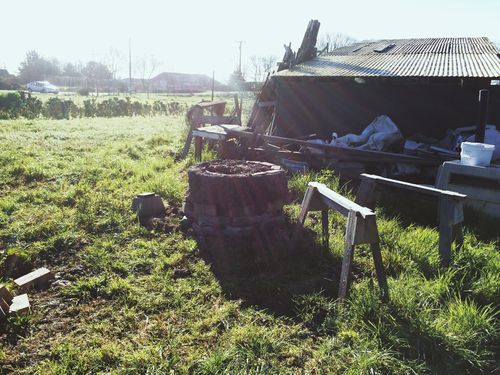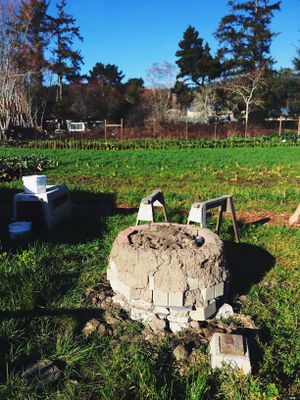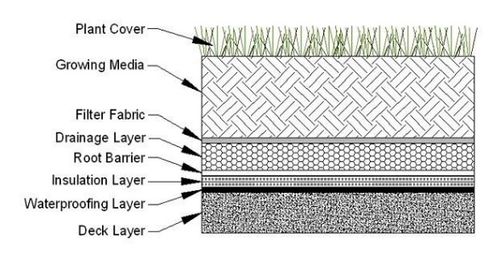A.R.Shearer (talk | contribs) (→Costs) |
A.R.Shearer (talk | contribs) (→Costs) |
||
| Line 201: | Line 201: | ||
|align="right"| 9.00 | |align="right"| 9.00 | ||
|- | |- | ||
| 1 || Soil-28L || | | 1 || Soil-28L || Donated By Farm | ||
|align="right"| | |align="right"| 00.00 | ||
|align="right"| | |align="right"| 00.00 | ||
|- | |- | ||
| 1 || Growing medium-6qt || Pierson Building Center | | 1 || Growing medium-6qt || Pierson Building Center | ||
| Line 238: | Line 238: | ||
|-class="sortbottom" | |-class="sortbottom" | ||
|colspan="4" align="right" | '''Total Cost''' | |colspan="4" align="right" | '''Total Cost''' | ||
|align="right"| '''$ | |align="right"| '''$169.60''' | ||
|} | |} | ||
[[Category:Engr305 Appropriate Technology]] | [[Category:Engr305 Appropriate Technology]] | ||
Revision as of 21:26, 4 March 2015
Background
Bayside Park Farm located in Arcata California in the United States and also goes by the name Arcata Educational Farm. It is a Community Supported Agriculture (CSA) facility that also acts as an educational farm. Our (Caroline, Mayara, and Amber’s) Engineering 305 class during the North American Spring 2015 semester will be constructing a functioning living roof. This living roof must attend to the owner's specifications regarding its dimensions and purpose, which are that the living roof be made to shelter a cob oven that is in the process of being made and will be increased about two feet in diameter. This means that the living roof needs to be made so that the roof itself may be attached at a later time, allowing the cob oven to be built. The construction and development of the living roof will span from January 2015 until May 2015.


Problem statement
The objective of this project is to implement a functional, sustainable and auto sufficient living roof at Bayside Park Farm. A green roof or living roof consists of a vegetation surface on the roof with a waterproof membrane. The green roof, also known as garden roof or living roof, is used as an alternative storm water system which increases the pervious area. Furthermore it can be used for controlling runoff volume, improving air and water quality, promoting energy conservation, and providing food and an ecosystem within an urban area. Additionally, where applicable, we also plan on using affordable and recycled materials on its implementation. No less important, by doing so we also aim to provide one more green and cultivable area to the farm, thereby raising its productivity and reducing runoffs and flooding.
Criteria
The criteria was defined accordingly to customer purposes and preferences. The scale (1-10) represents the importance level of meeting the constraint of each listed criteria.
| Criteria | Constraints | Weight (1-10) |
|---|---|---|
| Functionality | Must serve recreational and educational purposes. | |
| Maintainability | Must be low and easy maintenance. | |
| Aesthetics | Must be pleasing to the eye. | |
| Safety | Must not interfere with walking paths and have a stable structure. | |
| Weight | Must be able to hold at least 20lbs per square meter. | |
| Durability/Resistance | Must be able to last for a long time and be weather resistant. |
Literature Review
Living roof basics
The basic components of green roof systems are waterproofing, soil and plants. However, although the combination of these components seems easy, the success of green roofs systems depends on the understanding the interaction among the parts and its complexity.[1] Useful tool in the Santa Rosa’s LID Design Manual is the “Storm Water Calculator.” The calculator can be found in an excel file at www.srcity.org/stormwaterLID . The green roof design is best done during the design of the building and will need to hold at least 20 lb per square foot [2]. In Humboldt County earthquakes pose a risk, design should account for potential catastrophic earthquakes and the forces it will create on the building. Drainage and irrigation are important aspects of the design based on the dry periods and extreme precipitation events. The formula to calculate the weight of soil on a grass roof: Soil Load(psf)=Soil Density(lb/ft3) x (Soil Depth (inches)/12) [3]
Living roof concerns
One concern may be the water-quality of the storm water runoff from living roofs. The water discharge from living roofs may be a new source of surface-water pollution because of the organic matter and nutrient content found in the growing medium of the roof membrane. There has been some research that shows living roofs as having increased levels of phosphorus and nitrogen leaching from the substrate.[4]
Another concern may be the types of vegetation being used. Plant communities have a huge influence on the performance of living roofs. The plants' ability to resist environmental fluctuations and recover from them and the rate at which resources can be consumed affect the performance of the roof. On living roofs, wind stress is a main factor in the low performance of living roofs mostly because of the building height, but that should not negate that on any living roof wind stress has the potential to wipe out the plant community on that roof. Using native plants may be a possible way to increase the living roof's performance because native plants are already accustomed to the local environmental conditions. However, there has been some research that shows that in extensive living roof systems the native plants do poorly because of the shallow substrate depths (the focus is on extensive living roofs because that is the ideal roof for our project). This then means that not only is wind stress the main factor in determining the types of flora being used but that the rooftop itself is challenging for the survival of plants. “Moisture stress and severe drought, extreme {usually elevated) temperatures, high light intensities, and high wind speeds increase the risk of desiccation and physical damage to vegetation and substrate.”[4]
Types of Living Roofs
Intensive
Suitable for underground garages and heavy buildings. Soil depth 15 cm. Areas is used as much as possible. Area has a high plant diversity. Conventional garden where plants tend to be maintained on an individual basis in the same way a garden ground level. High maintenance and irrigation system.[5][6][7] “Intensive green roofs are often accessible and are characterized by: deeper soil and greater weight, higher capital costs, increased plant diversity, and more maintenance requirements. The growing medium is often soil based, ranging in depth from 20–60 cm (8-24"), with a saturated weight increase of between 290 - 967.7 kg/m2 (60-200 lbs/sf). Due to the increased soil depth, the plant selection is more diverse and can include trees and shrubs, which allows for the development of a more complex ecosystem. Requirements for maintenance - especially watering - are more demanding and ongoing, and irrigation systems are usually specified.”[7] [8]
Advantages of Intensive roofs:
- Diversity of plants
- Good insulation properties
- Simulate wildlife garden
- Attractive aesthetically
- Accessable/recreation
- Longer membrane life
- Energy efficient
- Storm water retention capability
Disadvantages of Intensive roofs:
- Greater weight load on roof
- Need irrigation and drainage system
- High maintenance and cost
- More complex[7]
Extensive
Thin substrate depths 2-15cm. This means lower in extra loading. Cheaper and easy maintenance. Aesthetically looks the same as other living roofs. “The extensive solution is suitable for lightweight and low height buildings: the utilised plants are species of sedum, shrubs and bushes that need low maintenance and can be self-generative. [6][5] [8]
“Extensive green roofs are often not accessible and are characterized by: low weight, low capital cost, low plant diversity, and minimal maintenance requirements. The growing medium, typically made up of a mineral-based mixture of sand, gravel, crushed brick, leca, peat, organic matter, and some soil, varies in depth between 5-15 cm (2-6") with a weight increase of between 72.6-169.4 kg / m2 (16-35 lbs/sf) when fully saturated. Due to the shallowness of the growing medium and the extreme desert-like microclimate on many roofs, plants must be low and hardy, typically alpine, dryland, or indigenous. Typically the plants are watered and fertilized only until they are established, and after the first year, maintenance consists of two visits a year for weeding of invasive species, safety and membrane inspections.”[7]
Advantages of Extensive roofs:
- Lightweight. Generally no reinforcement.
- Suitable for large areas.
- Roof slope 0degrees-30degrees
- Long life and low maintenance
- No need for irrigation or specialized drainage system.
- Less technical expertise needed
- Suitable for retrofit projects
- Inexpensive
- Looks more natural
- Vegetation can grow spontaneously
Disadvantages of Extensive roofs:
- Less energy efficient
- Less storm water retention benefits
- Limited choice of plants
- Not accessible for recreation or other uses
- Unattractive usually in the winter season[7]
Semi-Extensive
Low or no-input philosophy like Extensive roofs. Deeper layers of growing medium 10-20cm like Intensive roofs allowing for a wider and diverse range of plants.[5]
Living roof design
The basic components of green roof systems are waterproofing, soil and plants. However, although the combination of these components seems easy, the success of green roofs systems depends on the understanding the interaction among the parts and its complexity. [1] A green roof is composed of different layers which are described below:
Layers

- Deck Layer: is the foundation of a green roof and may be of concrete, wood, metal, plastic or a composite material.[9]
- Leak Detection System (optional). Leak detection systems are often installed above the deck layer to identify leaks, minimize leak damage through timely detection, and locate leak locations. [9]
- Waterproofing Layer: very important to prevent water damage through the deck layer. This layer must be entirely waterproof and long lasting. Several waterproofing materials can be used, like thermoplastic membranes, elastomeric membranes, modified bitumen polyvinyl chloride (PVC), applied rubberized asphalt, built up bitumen and others. The waterproofing material may be loose laid or bonded, which is more recommended. [9]
- Insulation Layer (optional): usually located above, but sometimes below, the waterproofing layer. Its function is to increase the energy efficiency. Recommended for metal roofs.[9]
- Root Barrier: used to protect the waterproofing membrane from root penetration.[9]
- Drainage Layer: placed between the root barrier and the growing media to remove excess water from the vegetation root zone. Must consist of synthetic or inorganic materials. The thickness of the drainage layer type is an important design decision. For extensive green roof systems, the depth of the drainage layer usually varies from 0.25 to 1.5 inches thick and increases for intensive designs. [9]
- Filter Sheet: consists in a “semi-permeable needled polypropylene filter fabric placed between the drainage layer and the growing media” in order to prevent the drainage layer to clog by the migration of some particles from the media into it. The filter sheet must allow the water migration into the drainage layer. [9]
- Growing Media: usually 3 to 6 inches deep and composed of approximately 70 to 80 percent lightweight inorganic materials like clays, pumice, scoria or other similar materials. The remaining media must not exceed 30 percent organic matter because it can transport nutrients into the runoff from the roof and clog the permeable filter sheet. [9]
- Plant Cover: it is the top layer and consists of plants that are non-native, slow-growing, shallow-rooted and perennial. The selected plants must be able to withstand harsh conditions at the roof surface. For drought periods it is recommended the installation of a watering system. [9]
Proposed timeline
| Weeks | Tasks | Observation |
|---|---|---|
| 16-Fev | Prototype budget and get the materials | |
| 23-Fev | Build the prototype | |
| 2-Mar | Build the prototype | |
| 9-Mar | Find donation, materials, weekly checks | Wait until the plants grow |
| 16-Mar | Find donation, materials, weekly checks | Wait until the plants grow |
| 23-Mar | Find donation, materials, weekly checks | Wait until the plants grow |
| 30-Mar | Analyse if everything is ok, recalculate | |
| 6-Apr | Build the real one | |
| 13-Apr | Build the real one | |
| 20-Apr | Build the real one | |
| 27-Apr | Verify functionality | |
| 4-May | Verify functionality | |
| 11-May | Verify functionality |
Costs
This is a proposed budget. We are hoping these items will be donated.
| Quantity | Material | Source | Cost ($) | Total ($) |
|---|---|---|---|---|
| 1 | Pond liner-10ft x 12ft | Pierson Building Center | 70.00 | 70.00 |
| 1 | Landscaping fabric-3' x 25' | Pierson Building Center | 9.00 | 9.00 |
| 1 | Soil-28L | Donated By Farm | 00.00 | 00.00 |
| 1 | Growing medium-6qt | Pierson Building Center | 3.00 | 3.00 |
| 1 | Wood Glue-18oz | Pierson Building Center | 6.00 | 6.00 |
| 36 | Stainless Steel Wood Screws | Pierson Building Center | 0.85 | 30.60 |
| 1 | Wood Preserver Paint-32 oz | Pierson Building Center | 10.00 | 10.00 |
| 1 | Rubber membrane-5' x 6 ' | Pierson Building Center | 32.00 | 32.00 |
| 1 | Shower Pan Liner Adhesive-16oz | Pierson Building Center | 9.00 | 9.00 |
| 5 | Wood | Donated By Farm | 00.00 | 00.00 |
| 1 | Plants | Donated By Farm | 00.00 | 00.00 |
| Total Cost | $169.60 | |||
References
- ↑ 1.0 1.1 Weiler, S.K. and Scholz-Barth. 2011. "Green rood system: A Guide to the Planning, Design,and Construction of Landscapes over Structure".
- ↑ Jones, Matthew. Green Roof Structural Design Powerpoint. Pdf. http://www.bae.ncsu.edu/topic/lidconference07/Post%20Conference%20Green%20Roof/3.Jones.Green%20Roof%20Structural%20Design.pdf.
- ↑ "Tule Fog Farm Grassfed Shed." - Appropedia: The Sustainability Wiki. Accessed February 9, 2015. http://www.appropedia.org/Tule_Fog_Farm_Grassfed_Shed.
- ↑ 4.0 4.1 Oberndorfer, Erica, Jeremy Lundholm, Brad Bass, Reid R. Coffman, Hitesh Doshi, Nigel Dunnett, Stuart Gaffin, Manfred Köhler, Karen K. Y. Liu, and Bradley Rowe. 2007. “Green Roofs as Urban Ecosystems: Ecological Structures, Functions, and Services. (Cover Story).” BioScience 57 (10): 823–33.
- ↑ 5.0 5.1 5.2 Dunnett, Nigel, and Noel Kingsbury. Planting Green Roofs and Living Walls. Portland: Timber Press, 2008.
- ↑ 6.0 6.1 Lazzarin, Renato M., Francesco Castellotti, and Filippo Busato. 2005. “Experimental Measurements and Numerical Modelling of a Green Roof.” Energy and Buildings 37 (12): 1260–67.
- ↑ 7.0 7.1 7.2 7.3 7.4 Peck, S. and M. Kuhn. 2003. Design Guidelines for Green Roofs (PDF) (22 pp, 551K). Canada Mortgage and Housing Corporation and the Ontario Association of Architects
- ↑ 8.0 8.1 "Green Roof Systems: Intensive, Semi-Intensive, and Extensive.".Architect's Technical Reference. Accessed February 8, 2015. http://www.archtoolbox.com/materials-systems/site-landscape/green-roofs.html..
- ↑ 9.0 9.1 9.2 9.3 9.4 9.5 9.6 9.7 9.8 "Hoffmann, G., Stack, R.C. and Wye, B.V. 2012. “Stormwater Management Guidebook”.